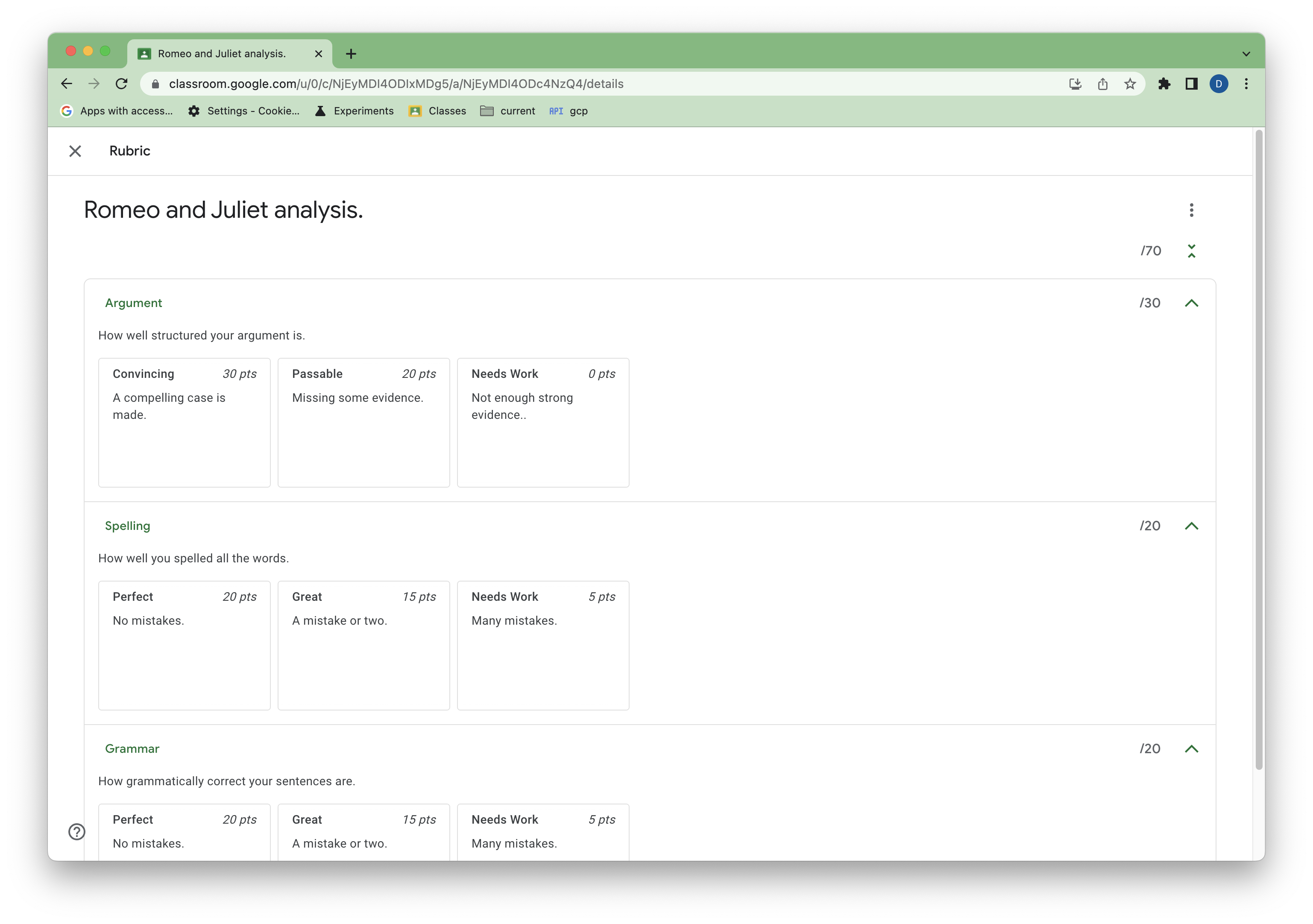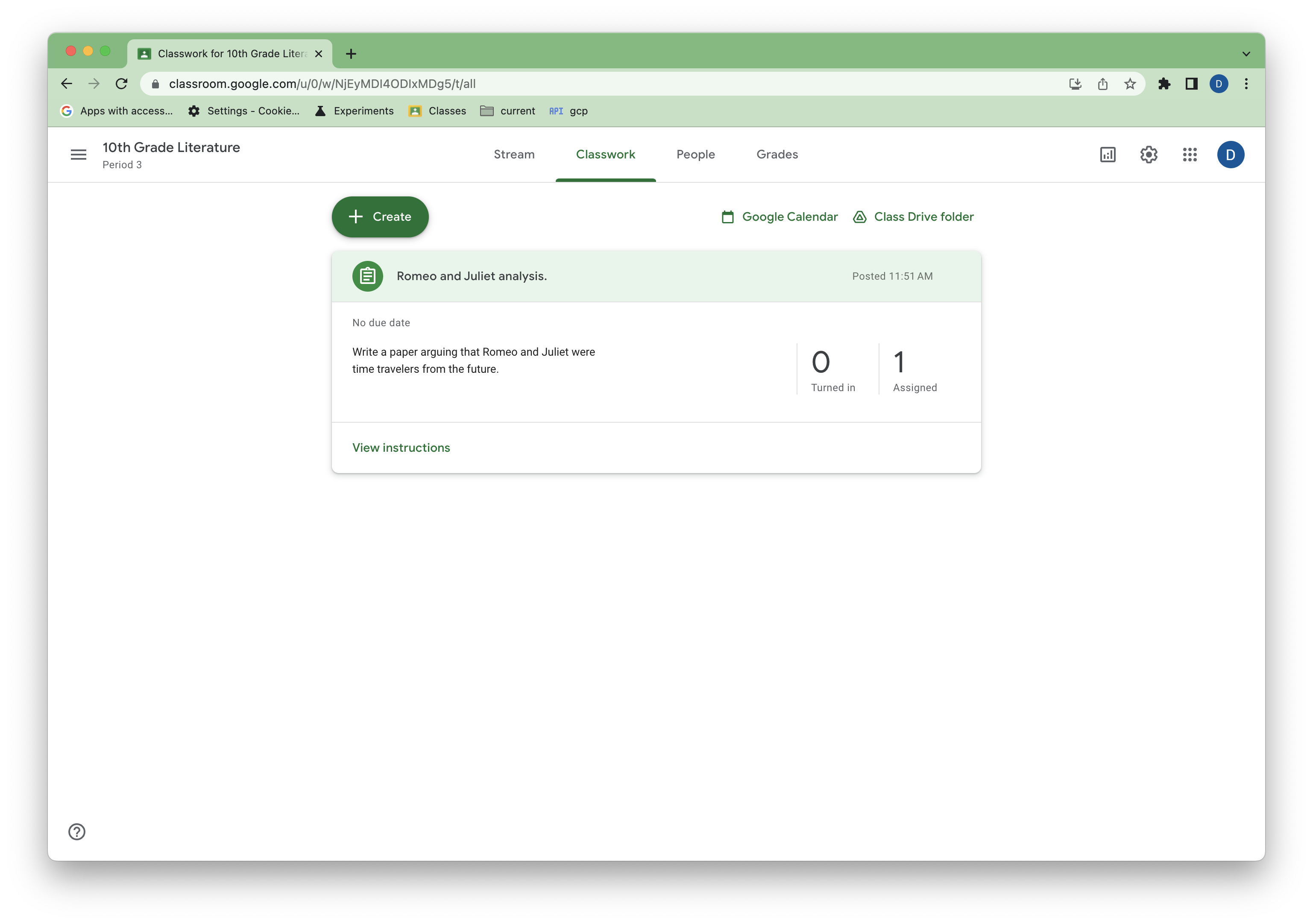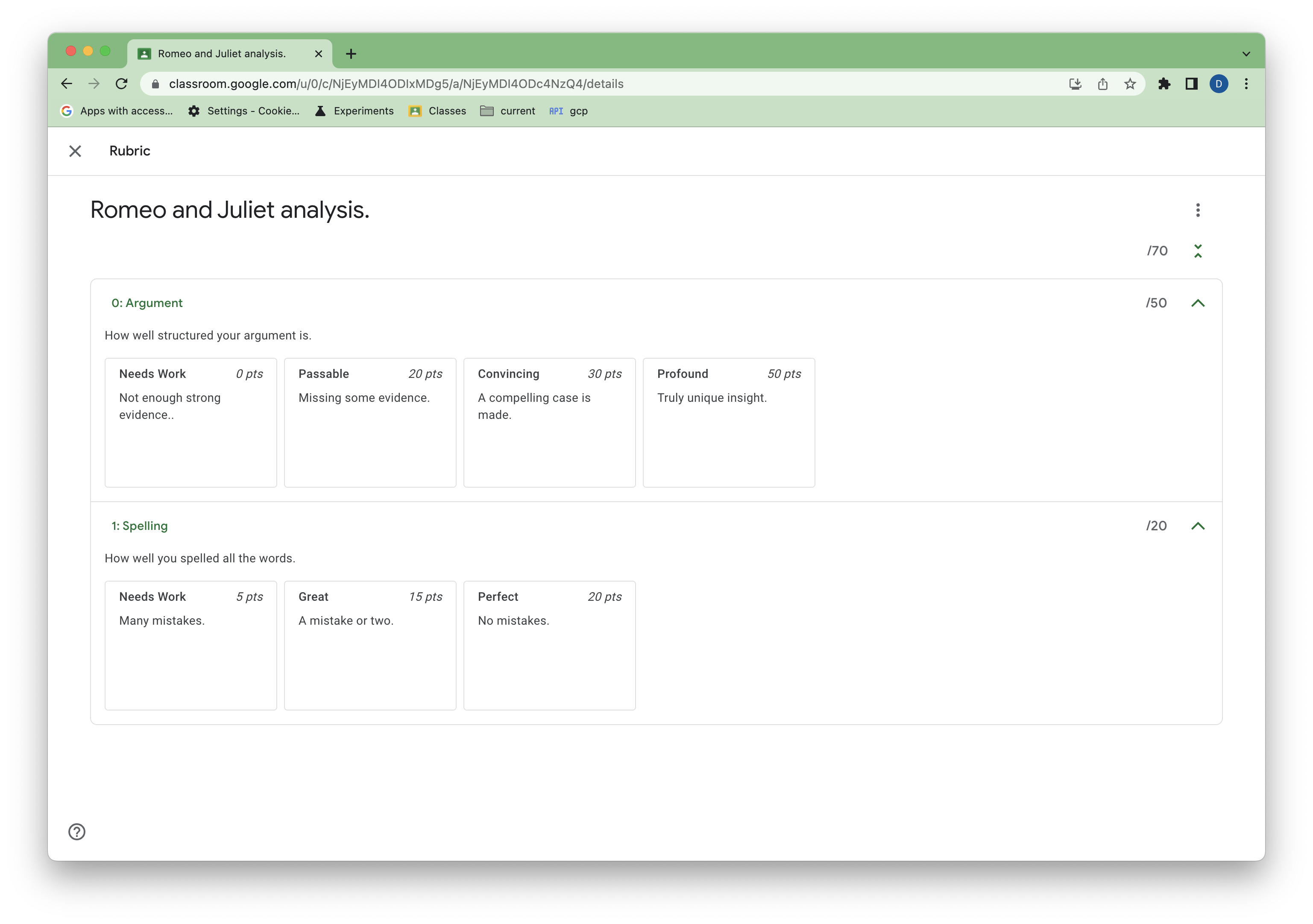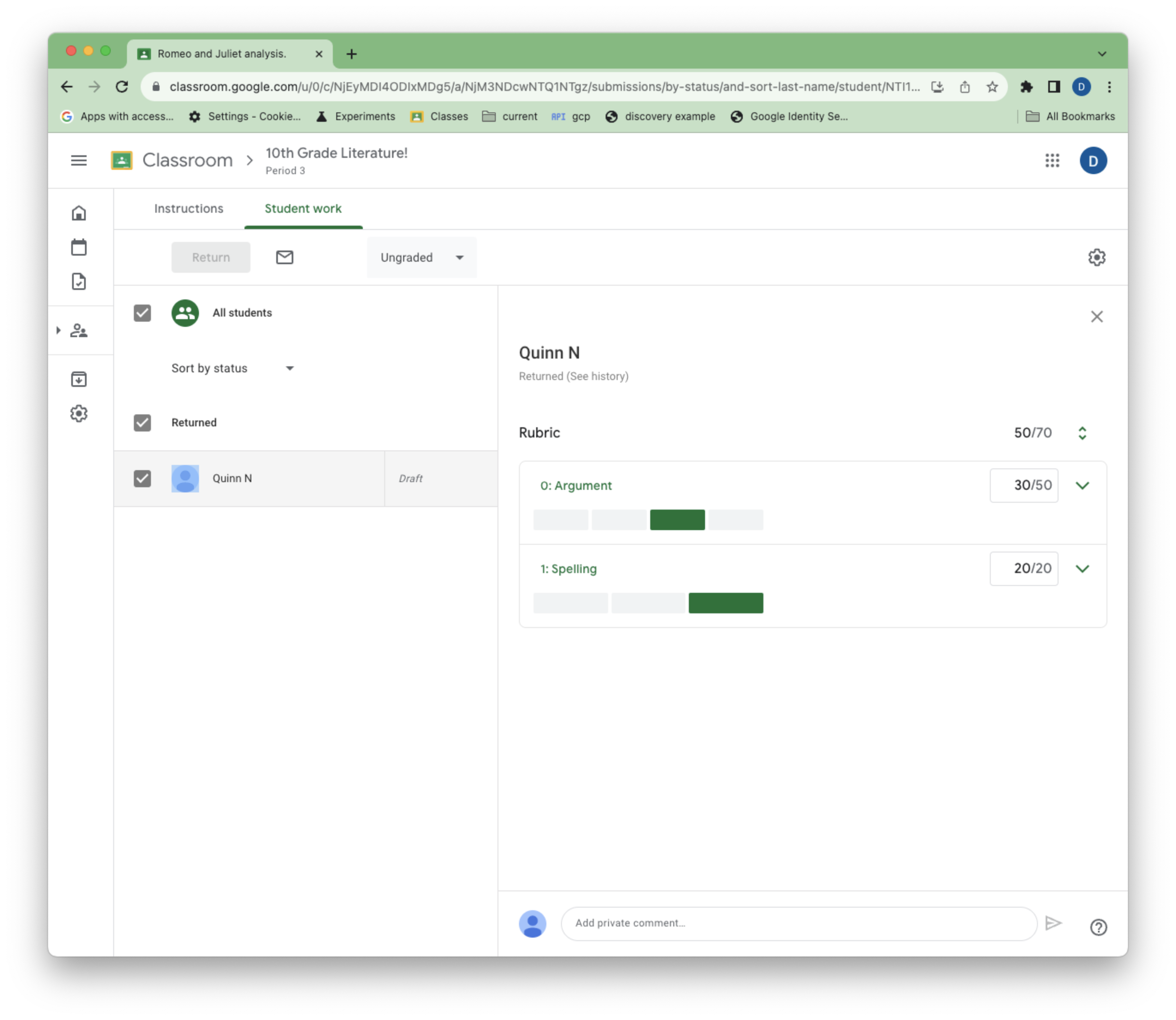rubric คือเทมเพลตที่ครูสามารถใช้เมื่อให้คะแนนงานที่ส่งของนักเรียน Classroom API ช่วยให้คุณดำเนินการในนามของอาจารย์เพื่อจัดการรูปแบบการให้คะแนนเหล่านี้ได้
 รูปที่ 1 ตัวอย่างเกณฑ์การให้คะแนนงานใน Classroom
รูปที่ 1 ตัวอย่างเกณฑ์การให้คะแนนงานใน Classroom
คู่มือนี้จะอธิบายแนวคิดพื้นฐานและฟังก์ชันการทำงานของ Rubrics API อ่านบทความเหล่านี้ในศูนย์ช่วยเหลือเพื่อดูข้อมูลเกี่ยวกับโครงสร้างทั่วไปของรูปแบบการให้คะแนนและวิธีให้คะแนนตามรูปแบบการให้คะแนนใน UI ของ Classroom
ข้อกำหนดเบื้องต้น
คู่มือนี้จะถือว่าคุณมีสิ่งต่อไปนี้
- Python 3.8.6 ขึ้นไป
- เครื่องมือจัดการแพ็กเกจ pip
- โปรเจ็กต์ Google Cloud
- บัญชี Google Workspace for Education ที่เปิดใช้ Google Classroom
- ชั้นเรียนทดสอบที่มีบัญชีนักเรียนทดสอบอย่างน้อย 1 บัญชี หากไม่มีชั้นเรียน Classroom ที่จะใช้ในการทดสอบ ให้สร้างชั้นเรียนใน UI แล้วเพิ่มนักเรียนทดสอบ
ให้สิทธิ์ข้อมูลเข้าสู่ระบบสำหรับแอปพลิเคชันบนเดสก์ท็อป
หากต้องการตรวจสอบสิทธิ์ในฐานะผู้ใช้ปลายทางและเข้าถึงข้อมูลผู้ใช้ในแอป คุณจะต้องสร้างรหัสไคลเอ็นต์ OAuth 2.0 อย่างน้อย 1 รายการ รหัสไคลเอ็นต์ใช้เพื่อระบุแอปเดี่ยวไปยังเซิร์ฟเวอร์ OAuth ของ Google หากแอปทำงานบนหลายแพลตฟอร์ม คุณต้องสร้างรหัสไคลเอ็นต์แยกต่างหากสำหรับแต่ละแพลตฟอร์ม
- ไปที่หน้าข้อมูลเข้าสู่ระบบของ Google Cloud ในคอนโซล Google Cloud
- คลิกสร้างข้อมูลเข้าสู่ระบบ > รหัสไคลเอ็นต์ OAuth
- คลิกประเภทแอปพลิเคชัน > แอปเดสก์ท็อป
- พิมพ์ชื่อของข้อมูลเข้าสู่ระบบในช่องชื่อ ชื่อนี้จะแสดงในคอนโซล Google Cloud เท่านั้น เช่น "ไคลเอ็นต์ตัวอย่าง Rubrics"
- คลิกสร้าง หน้าจอ "สร้างไคลเอ็นต์ OAuth แล้ว" จะปรากฏขึ้นพร้อมแสดงรหัสไคลเอ็นต์และรหัสลับไคลเอ็นต์ใหม่
- คลิกดาวน์โหลด JSON แล้วคลิกตกลง ข้อมูลเข้าสู่ระบบที่สร้างขึ้นใหม่จะปรากฏในส่วนรหัสไคลเอ็นต์ OAuth 2.0
- บันทึกไฟล์ JSON ที่ดาวน์โหลดเป็น
credentials.jsonแล้วย้ายไฟล์ไปยังไดเรกทอรีทํางาน - คลิกสร้างข้อมูลเข้าสู่ระบบ > คีย์ API แล้วจดคีย์ API ไว้
ดูข้อมูลเพิ่มเติมได้ที่สร้างข้อมูลเข้าสู่ระบบ
กำหนดค่าขอบเขต OAuth
คุณอาจต้องกำหนดค่าขอบเขตเพิ่มเติม ทั้งนี้ขึ้นอยู่กับขอบเขต OAuth ที่มีอยู่ของโปรเจ็กต์
- ไปที่หน้าจอขอความยินยอม OAuth
- คลิกแก้ไขแอป > บันทึกและดำเนินการต่อเพื่อไปที่หน้าจอขอบเขต
- คลิกเพิ่มหรือนำขอบเขตออก
- เพิ่มขอบเขตต่อไปนี้หากยังไม่มี
https://www.googleapis.com/auth/classroom.coursework.studentshttps://www.googleapis.com/auth/classroom.courses
- จากนั้นคลิกอัปเดต > บันทึกและดำเนินการต่อ > บันทึกและดำเนินการต่อ > กลับไปยังหน้าแดชบอร์ด
ดูข้อมูลเพิ่มเติมที่หัวข้อกำหนดค่าหน้าจอขอความยินยอม OAuth
ขอบเขต classroom.coursework.students จะให้สิทธิ์การอ่านและเขียนรูปแบบการให้คะแนน (รวมถึงสิทธิ์เข้าถึง CourseWork) และขอบเขต classroom.courses จะให้สิทธิ์การอ่านและเขียนหลักสูตร
ขอบเขตที่จําเป็นสําหรับเมธอดหนึ่งๆ จะแสดงอยู่ในเอกสารอ้างอิงสําหรับเมธอดนั้น ดูตัวอย่างได้ที่courses.courseWork.rubrics.createขอบเขตการให้สิทธิ์
คุณดูขอบเขต Classroom ทั้งหมดได้ในขอบเขต OAuth 2.0 สำหรับ Google API ไม่ได้กล่าวถึงรูปแบบการให้คะแนนที่นี่เนื่องจาก API ยังอยู่ในเวอร์ชันตัวอย่าง
กำหนดค่าตัวอย่าง
ติดตั้งไลบรารีของไคลเอ็นต์ Google สำหรับ Python ในไดเรกทอรีทํางานโดยทําดังนี้
pip install --upgrade google-api-python-client google-auth-httplib2 google-auth-oauthlib
สร้างไฟล์ชื่อ main.py ที่สร้างไลบรารีของไคลเอ็นต์และให้สิทธิ์ผู้ใช้ โดยใช้คีย์ API แทน YOUR_API_KEY
import json
import os.path
from google.auth.transport.requests import Request
from google.oauth2.credentials import Credentials
from google_auth_oauthlib.flow import InstalledAppFlow
from googleapiclient.discovery import build
from googleapiclient.errors import HttpError
# If modifying these scopes, delete the file token.json.
SCOPES = ['https://www.googleapis.com/auth/classroom.courses',
'https://www.googleapis.com/auth/classroom.coursework.students']
def build_authenticated_service(api_key):
"""Builds the Classroom service."""
creds = None
# The file token.json stores the user's access and refresh tokens, and is
# created automatically when the authorization flow completes for the first
# time.
if os.path.exists('token.json'):
creds = Credentials.from_authorized_user_file('token.json', SCOPES)
# If there are no (valid) credentials available, let the user log in.
if not creds or not creds.valid:
if creds and creds.expired and creds.refresh_token:
creds.refresh(Request())
else:
flow = InstalledAppFlow.from_client_secrets_file(
'credentials.json', SCOPES)
creds = flow.run_local_server(port=0)
# Save the credentials for the next run.
with open('token.json', 'w') as token:
token.write(creds.to_json())
try:
# Build the Classroom service.
service = build(
serviceName="classroom",
version="v1",
credentials=creds,
discoveryServiceUrl=f"https://classroom.googleapis.com/$discovery/rest?labels=DEVELOPER_PREVIEW&key={api_key}")
return service
except HttpError as error:
print('An error occurred: %s' % error)
if __name__ == '__main__':
service = build_authenticated_service(YOUR_API_KEY)
เรียกใช้สคริปต์โดยใช้ python main.py ระบบจะแจ้งให้คุณลงชื่อเข้าใช้และให้ความยินยอมในขอบเขต OAuth
สร้างงาน
รูปแบบการให้คะแนนจะเชื่อมโยงกับงานหรือ CourseWork และจะมีความหมายเฉพาะในบริบทของ CourseWork นั้นๆ มีเพียงโปรเจ็กต์ Google Cloud ที่สร้างรายการ CourseWork หลักเท่านั้นที่สร้างเกณฑ์การให้คะแนนได้ เพื่อสร้างCourseWorkงานใหม่ที่มีสคริปต์ตามวัตถุประสงค์ของคู่มือนี้
เพิ่มรายการต่อไปนี้ลงใน main.py
def get_latest_course(service):
"""Retrieves the last created course."""
try:
response = service.courses().list(pageSize=1).execute()
courses = response.get("courses", [])
if not courses:
print("No courses found. Did you remember to create one in the UI?")
return
course = courses[0]
return course
except HttpError as error:
print(f"An error occurred: {error}")
return error
def create_coursework(service, course_id):
"""Creates and returns a sample coursework."""
try:
coursework = {
"title": "Romeo and Juliet analysis.",
"description": """Write a paper arguing that Romeo and Juliet were
time travelers from the future.""",
"workType": "ASSIGNMENT",
"state": "PUBLISHED",
}
coursework = service.courses().courseWork().create(
courseId=course_id, body=coursework).execute()
return coursework
except HttpError as error:
print(f"An error occurred: {error}")
return error
ตอนนี้อัปเดต main.py เพื่อเรียกข้อมูล course_id ของชั้นเรียนทดสอบที่คุณเพิ่งสร้างขึ้น สร้างงานตัวอย่างใหม่ และเรียกข้อมูล coursework_id ของงาน
if __name__ == '__main__':
service = build_authenticated_service(YOUR_API_KEY)
course = get_latest_course(service)
course_id = course.get("id")
course_name = course.get("name")
print(f"'{course_name}' course ID: {course_id}")
coursework = create_coursework(service, course_id)
coursework_id = coursework.get("id")
print(f"Assignment created with ID {coursework_id}")
#TODO(developer): Save the printed course and coursework IDs.
บันทึก course_id และ coursework_id รายการเหล่านี้จำเป็นสำหรับการดำเนินการ CRUD ของข้อกำหนดทั้งหมด
ตอนนี้คุณควรมีตัวอย่าง CourseWork ใน Classroom แล้ว
 รูปที่ 2 มุมมองตัวอย่างงานใน Classroom
รูปที่ 2 มุมมองตัวอย่างงานใน Classroom
สร้างเกณฑ์การให้คะแนน
ตอนนี้คุณก็พร้อมที่จะเริ่มจัดการรูปแบบการให้คะแนนแล้ว
คุณสร้างเกณฑ์การให้คะแนนใน CourseWork ได้ด้วยการเรียกใช้ Create ที่มีออบเจ็กต์เกณฑ์การให้คะแนนแบบสมบูรณ์ โดยระบบจะไม่ระบุพร็อพเพอร์ตี้รหัสสำหรับเกณฑ์และระดับ (ระบบจะสร้างพร็อพเพอร์ตี้เหล่านี้เมื่อสร้าง)
เพิ่มฟังก์ชันต่อไปนี้ลงใน main.py
def create_rubric(service, course_id, coursework_id):
"""Creates an example rubric on a coursework."""
try:
body = {
"criteria": [
{
"title": "Argument",
"description": "How well structured your argument is.",
"levels": [
{"title": "Convincing",
"description": "A compelling case is made.", "points": 30},
{"title": "Passable",
"description": "Missing some evidence.", "points": 20},
{"title": "Needs Work",
"description": "Not enough strong evidence..", "points": 0},
]
},
{
"title": "Spelling",
"description": "How well you spelled all the words.",
"levels": [
{"title": "Perfect",
"description": "No mistakes.", "points": 20},
{"title": "Great",
"description": "A mistake or two.", "points": 15},
{"title": "Needs Work",
"description": "Many mistakes.", "points": 5},
]
},
{
"title": "Grammar",
"description": "How grammatically correct your sentences are.",
"levels": [
{"title": "Perfect",
"description": "No mistakes.", "points": 20},
{"title": "Great",
"description": "A mistake or two.", "points": 15},
{"title": "Needs Work",
"description": "Many mistakes.", "points": 5},
]
},
]
}
rubric = service.courses().courseWork().rubrics().create(
courseId=course_id, courseWorkId=coursework_id, body=body,
# Specify the preview version. Rubrics CRUD capabilities are
# supported in V1_20231110_PREVIEW and later.
previewVersion="V1_20231110_PREVIEW"
).execute()
print(f"Rubric created with ID {rubric.get('id')}")
return rubric
except HttpError as error:
print(f"An error occurred: {error}")
return error
จากนั้นอัปเดตและเรียกใช้ main.py เพื่อสร้างตัวอย่างรูปแบบการให้คะแนนโดยใช้รหัส Course
และ CourseWork จากก่อนหน้านี้
if __name__ == '__main__':
service = build_authenticated_service(YOUR_API_KEY)
rubric = create_rubric(service, YOUR_COURSE_ID, YOUR_COURSEWORK_ID)
print(json.dumps(rubric, indent=4))
ประเด็นสำคัญเกี่ยวกับการแสดงผลของเกณฑ์การให้คะแนน
- เกณฑ์และลําดับระดับจะแสดงใน UI ของ Classroom
- ระดับที่มีคะแนน (ระดับที่มีพร็อพเพอร์ตี้
points) ต้องจัดเรียงตามคะแนนในลำดับจากน้อยไปมากหรือมากไปน้อย (ไม่สามารถจัดเรียงแบบสุ่ม) - ครูสามารถจัดเรียงเกณฑ์และระดับการให้คะแนนใหม่ (แต่จัดเรียงระดับที่ไม่มีคะแนนไม่ได้) ใน UI ซึ่งจะเปลี่ยนลำดับของเกณฑ์และระดับการให้คะแนนในข้อมูล
ดูข้อควรระวังเพิ่มเติมเกี่ยวกับโครงสร้างของเกณฑ์การให้คะแนนได้ที่ข้อจำกัด
เมื่อกลับไปที่ UI คุณควรเห็นเกณฑ์การให้คะแนนในงาน
 รูปที่ 3 ตัวอย่างเกณฑ์การให้คะแนนงานใน Classroom
รูปที่ 3 ตัวอย่างเกณฑ์การให้คะแนนงานใน Classroom
อ่านเกณฑ์การให้คะแนน
เกณฑ์การให้คะแนนจะอ่านได้ด้วยวิธีการมาตรฐาน List และ Get
งานมีเกณฑ์การให้คะแนนได้สูงสุด 1 รายการ ดังนั้น List จึงอาจดูไม่ตรงไปตรงมา แต่มีประโยชน์ในกรณีที่คุณยังไม่มีรหัสเกณฑ์การให้คะแนน หากไม่มีเกณฑ์ที่เชื่อมโยงกับ CourseWork คำตอบ List จะว่างเปล่า
เพิ่มฟังก์ชันต่อไปนี้ลงใน main.py
def get_rubric(service, course_id, coursework_id):
"""
Get the rubric on a coursework. There can only be at most one.
Returns null if there is no rubric.
"""
try:
response = service.courses().courseWork().rubrics().list(
courseId=course_id, courseWorkId=coursework_id,
# Specify the preview version. Rubrics CRUD capabilities are
# supported in V1_20231110_PREVIEW and later.
previewVersion="V1_20231110_PREVIEW"
).execute()
rubrics = response.get("rubrics", [])
if not rubrics:
print("No rubric found for this assignment.")
return
rubric = rubrics[0]
return rubric
except HttpError as error:
print(f"An error occurred: {error}")
return error
อัปเดตและเรียกใช้ main.py เพื่อดึงข้อมูลเกณฑ์การให้คะแนนที่คุณเพิ่ม
if __name__ == '__main__':
service = build_authenticated_service(YOUR_API_KEY)
rubric = get_rubric(service, YOUR_COURSE_ID, YOUR_COURSEWORK_ID)
print(json.dumps(rubric, indent=4))
#TODO(developer): Save the printed rubric ID.
จดบันทึกพร็อพเพอร์ตี้ id ในตารางสรุปสำหรับขั้นตอนถัดไป
Get จะทำงานได้ดีเมื่อคุณมีรหัสรูปแบบการให้คะแนน การใช้ Get ในฟังก์ชันแทนอาจมีลักษณะดังนี้
def get_rubric(service, course_id, coursework_id, rubric_id):
"""
Get the rubric on a coursework. There can only be at most one.
Returns a 404 if there is no rubric.
"""
try:
rubric = service.courses().courseWork().rubrics().get(
courseId=course_id,
courseWorkId=coursework_id,
id=rubric_id,
# Specify the preview version. Rubrics CRUD capabilities are
# supported in V1_20231110_PREVIEW and later.
previewVersion="V1_20231110_PREVIEW"
).execute()
return rubric
except HttpError as error:
print(f"An error occurred: {error}")
return error
การใช้งานนี้จะแสดงผล 404 หากไม่มีรูบริก
อัปเดตเกณฑ์การให้คะแนน
การอัปเดตเกณฑ์การให้คะแนนจะดำเนินการด้วยการเรียกใช้ Patch เนื่องจากโครงสร้างของรูปแบบการให้คะแนนมีความซับซ้อน อัปเดตจึงต้องดำเนินการด้วยรูปแบบ read-modify-write ซึ่งจะแทนที่พร็อพเพอร์ตี้ criteria ทั้งหมด
กฎการอัปเดตมีดังนี้
- ระบบจะถือว่าเกณฑ์หรือระดับที่เพิ่มโดยไม่มีรหัสเป็นการเพิ่ม
- ระบบจะถือว่าเกณฑ์หรือระดับที่ไม่มีก่อนหน้านี้เป็นการลบ
- ระบบจะถือว่าเกณฑ์หรือระดับที่มีรหัสอยู่แล้วแต่มีการแก้ไขข้อมูลเป็นการแก้ไข ระบบจะไม่เปลี่ยนแปลงพร็อพเพอร์ตี้ที่ไม่ได้แก้ไข
- ระบบจะถือว่าเกณฑ์หรือระดับที่ระบุพร้อมกับรหัสใหม่หรือรหัสที่ไม่รู้จักเป็นข้อผิดพลาด
- ลำดับของเกณฑ์และระดับใหม่จะถือเป็นลำดับ UI ใหม่ (โดยมีข้อจำกัดที่ระบุไว้ข้างต้น)
เพิ่มฟังก์ชันสำหรับการอัปเดตเกณฑ์การให้คะแนน
def update_rubric(service, course_id, coursework_id, rubric_id, body):
"""
Updates the rubric on a coursework.
"""
try:
rubric = service.courses().courseWork().rubrics().patch(
courseId=course_id,
courseWorkId=coursework_id,
id=rubric_id,
body=body,
updateMask='criteria',
# Specify the preview version. Rubrics CRUD capabilities are
# supported in V1_20231110_PREVIEW and later.
previewVersion="V1_20231110_PREVIEW"
).execute()
return rubric
except HttpError as error:
print(f"An error occurred: {error}")
return error
ในตัวอย่างนี้ มีการระบุช่อง criteria ไว้สำหรับการแก้ไขด้วย updateMask
จากนั้นแก้ไข main.py เพื่อทําการเปลี่ยนแปลงกฎการอัปเดตแต่ละข้อที่ระบุไว้ข้างต้น
if __name__ == '__main__':
service = build_authenticated_service(YOUR_API_KEY)
# Get the latest rubric.
rubric = get_rubric(service, YOUR_COURSE_ID, YOUR_COURSEWORK_ID)
criteria = rubric.get("criteria")
"""
The "criteria" property should look like this:
[
{
"id": "NkEyMdMyMzM2Nxkw",
"title": "Argument",
"description": "How well structured your argument is.",
"levels": [
{
"id": "NkEyMdMyMzM2Nxkx",
"title": "Convincing",
"description": "A compelling case is made.",
"points": 30
},
{
"id": "NkEyMdMyMzM2Nxky",
"title": "Passable",
"description": "Missing some evidence.",
"points": 20
},
{
"id": "NkEyMdMyMzM2Nxkz",
"title": "Needs Work",
"description": "Not enough strong evidence..",
"points": 0
}
]
},
{
"id": "NkEyMdMyMzM2Nxk0",
"title": "Spelling",
"description": "How well you spelled all the words.",
"levels": [...]
},
{
"id": "NkEyMdMyMzM2Nxk4",
"title": "Grammar",
"description": "How grammatically correct your sentences are.",
"levels": [...]
}
]
"""
# Make edits. This example will make one of each type of change.
# Add a new level to the first criteria. Levels must remain sorted by
# points.
new_level = {
"title": "Profound",
"description": "Truly unique insight.",
"points": 50
}
criteria[0]["levels"].insert(0, new_level)
# Remove the last criteria.
del criteria[-1]
# Update the criteria titles with numeric prefixes.
for index, criterion in enumerate(criteria):
criterion["title"] = f"{index}: {criterion['title']}"
# Resort the levels from descending to ascending points.
for criterion in criteria:
criterion["levels"].sort(key=lambda level: level["points"])
# Update the rubric with a patch call.
new_rubric = update_rubric(
service, YOUR_COURSE_ID, YOUR_COURSEWORK_ID, YOUR_RUBRIC_ID, rubric)
print(json.dumps(new_rubric, indent=4))
ตอนนี้การเปลี่ยนแปลงควรแสดงใน Classroom สำหรับครูแล้ว
 รูปที่ 4 มุมมองของเกณฑ์การให้คะแนนที่อัปเดต
รูปที่ 4 มุมมองของเกณฑ์การให้คะแนนที่อัปเดต
ดูงานที่ส่งซึ่งให้คะแนนตามเกณฑ์
ขณะนี้ API ให้คะแนนงานที่ส่งของนักเรียนด้วยเกณฑ์การให้คะแนนไม่ได้ แต่คุณสามารถอ่านคะแนนตามเกณฑ์การให้คะแนนสำหรับงานที่ส่งซึ่งให้คะแนนด้วยเกณฑ์การให้คะแนนใน UI ของ Classroom ได้
ในฐานะนักเรียนใน UI ของ Classroom ให้ทำและส่งงานตัวอย่าง จากนั้นในฐานะครู ให้ให้คะแนนงานด้วยตนเองโดยใช้เกณฑ์การให้คะแนน
 รูปที่ 5 มุมมองของครูเกี่ยวกับเกณฑ์การให้คะแนนระหว่างการให้คะแนน
รูปที่ 5 มุมมองของครูเกี่ยวกับเกณฑ์การให้คะแนนระหว่างการให้คะแนน
งานที่ส่งของนักเรียนที่ได้รับการให้คะแนนด้วยเกณฑ์การให้คะแนนจะมีพร็อพเพอร์ตี้ใหม่ 2 รายการ ได้แก่ draftRubricGrades และ assignedRubricGrades ซึ่งแสดงคะแนนและระดับที่ครูเลือกไว้ในระหว่างสถานะร่างและสถานะการให้คะแนนที่กำหนด
นอกจากนี้ งานที่นักเรียนส่งซึ่งมีเกณฑ์การให้คะแนนที่เกี่ยวข้องจะมีช่อง rubricId
ด้วย แม้จะยังไม่ได้ให้คะแนนก็ตาม ค่านี้แสดงถึงรูปแบบการให้คะแนนล่าสุดที่เชื่อมโยงกับ CourseWork และค่านี้อาจเปลี่ยนแปลงหากครูลบและสร้างรูปแบบการให้คะแนนขึ้นมาใหม่
คุณสามารถใช้วิธีการที่มีอยู่สำหรับ studentSubmissions.Get และ studentSubmissions.List เพื่อดูงานที่ส่งซึ่งให้คะแนนแล้ว
เพิ่มฟังก์ชันต่อไปนี้ลงใน main.py เพื่อแสดงรายการงานที่ส่งของนักเรียน
def get_latest_submission(service, course_id, coursework_id):
"""Retrieves the last submission for an assignment."""
try:
response = service.courses().courseWork().studentSubmissions().list(
courseId = course_id,
courseWorkId = coursework_id,
pageSize=1,
# Specify the preview version. Rubrics CRUD capabilities are
# supported in V1_20231110_PREVIEW and later.
previewVersion="V1_20231110_PREVIEW"
).execute()
submissions = response.get("studentSubmissions", [])
if not submissions:
print(
"""No submissions found. Did you remember to turn in and grade
the assignment in the UI?""")
return
submission = submissions[0]
return submission
except HttpError as error:
print(f"An error occurred: {error}")
return error
จากนั้นอัปเดตและเรียกใช้ main.py เพื่อดูคะแนนการส่ง
if __name__ == '__main__':
service = build_authenticated_service(YOUR_API_KEY)
submission = get_latest_submission(
service, YOUR_COURSE_ID, YOUR_COURSEWORK_ID)
print(json.dumps(submission, indent=4))
draftRubricGrades และ assignedRubricGrades ประกอบด้วย
criterionIdของเกณฑ์การให้คะแนนที่เกี่ยวข้องpointsที่ครูกำหนดให้กับแต่ละเกณฑ์ ซึ่งอาจเป็นระดับที่เลือก แต่ครูอาจเขียนทับค่านี้ด้วยlevelIdของระดับที่เลือกสำหรับแต่ละเกณฑ์ หากครูไม่ได้เลือกระดับ แต่ยังคงให้คะแนนสำหรับเกณฑ์ ช่องนี้จะไม่ปรากฏ
รายการเหล่านี้จะมีเฉพาะรายการของเกณฑ์ที่ครูเลือกระดับหรือคะแนนสูงสุด เช่น หากครูเลือกที่จะโต้ตอบกับเกณฑ์เดียวระหว่างการให้คะแนน draftRubricGrades และ assignedRubricGrades จะมีเพียงรายการเดียว แม้ว่ารูปแบบการให้คะแนนจะมีหลายเกณฑ์ก็ตาม
ลบเกณฑ์การให้คะแนน
คุณลบเกณฑ์ได้ด้วยคำขอ Delete มาตรฐาน โค้ดต่อไปนี้แสดงตัวอย่างฟังก์ชันเพื่อความสมบูรณ์ แต่เนื่องจากเริ่มให้คะแนนแล้ว คุณจะลบเกณฑ์การให้คะแนนปัจจุบันไม่ได้
def delete_rubric(service, course_id, coursework_id, rubric_id):
"""Deletes the rubric on a coursework."""
try:
service.courses().courseWork().rubrics().delete(
courseId=course_id,
courseWorkId=coursework_id,
id=rubric_id,
# Specify the preview version. Rubrics CRUD capabilities are
# supported in V1_20231110_PREVIEW and later.
previewVersion="V1_20231110_PREVIEW"
).execute()
except HttpError as error:
print(f"An error occurred: {error}")
return error
ส่งออกและนำเข้าเกณฑ์การให้คะแนน
ครูสามารถส่งออกเกณฑ์การให้คะแนนไปยัง Google ชีตด้วยตนเองเพื่อใช้ซ้ำได้
นอกจากการระบุเกณฑ์การให้คะแนนในโค้ดแล้ว คุณยังสร้างและอัปเดตเกณฑ์การให้คะแนนจากชีตที่ส่งออกเหล่านี้ได้โดยระบุ sourceSpreadsheetId ในเนื้อหาของเกณฑ์การให้คะแนนแทน criteria
def create_rubric_from_sheet(service, course_id, coursework_id, sheet_id):
"""Creates an example rubric on a coursework."""
try:
body = {
"sourceSpreadsheetId": sheet_id
}
rubric = service.courses().courseWork().rubrics().create(
courseId=course_id, courseWorkId=coursework_id, body=body,
# Specify the preview version. Rubrics CRUD capabilities are
# supported in V1_20231110_PREVIEW and later.
previewVersion="V1_20231110_PREVIEW"
).execute()
print(f"Rubric created with ID {rubric.get('id')}")
return rubric
except HttpError as error:
print(f"An error occurred: {error}")
return error
ความคิดเห็น
หากพบปัญหาหรือมีความคิดเห็น โปรดแชร์ความคิดเห็น
